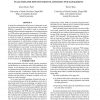Free Online Productivity Tools
i2Speak
i2Symbol
i2OCR
iTex2Img
iWeb2Print
iWeb2Shot
i2Type
iPdf2Split
iPdf2Merge
i2Bopomofo
i2Arabic
i2Style
i2Image
i2PDF
iLatex2Rtf
Sci2ools
SPIESR
2004
2004
Evaluating the effectiveness of automatic PVR management
A model for evaluating the effectiveness of automatic recording of television programs by digital personal video recorders (PVRs) is presented. The model is used to evaluate the tradeoff between manual management of recording programs to a PVR archive and automatic management of recording. We show that a tradeoff exists between manual management in which the utility of a program is perfectly known but user awareness of available programs is limited versus automatic management in which utility estimates contain error but awareness is perfect. Experiments with the model show that the shape of this tradeoff is most governed by the shape of the distribution of user utility. As the percentage of programs with high user utility decreases relative to the average, the more effective automatic recording is likely to be despite errors in utility estimation. The shape of this tradeoff, however, is highly inelastic. Thus, improving utility estimates will not make automatic recording more effectiv...
| Added | 31 Oct 2010 |
| Updated | 31 Oct 2010 |
| Type | Conference |
| Year | 2004 |
| Where | SPIESR |
| Authors | Ketan Mayer-Patel, Wesley Miaw |
Comments (0)

